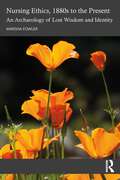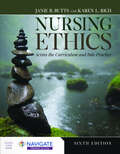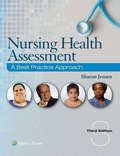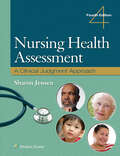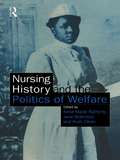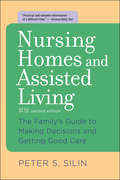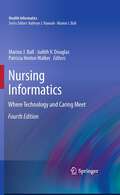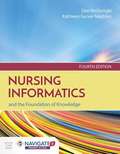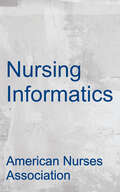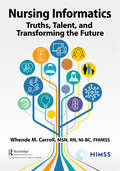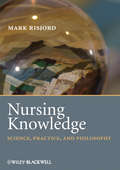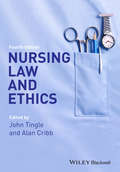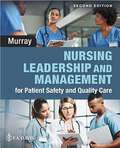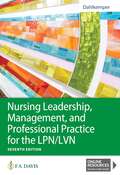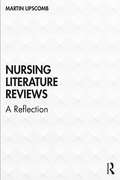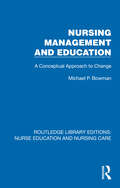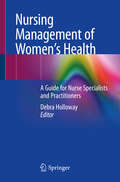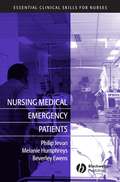- Table View
- List View
Nursing Ethics, 1880s to the Present: An Archaeology of Lost Wisdom and Identity
by Marsha FowlerThis important text draws on decades of research, arguing that modern nursing germinated and grew an ethics from its own native soil, which is rich, fulsome, and philosophically informed, grounded in the tradition and practice of nursing.It is an ethics with a positive agenda for the good nurse, a good society, a healthy people, and human flourishing. This native nursing ethics was forgotten, creating space for a foreign bioethics’ colonization of nursing in the second half of the twentieth century. Drawing from a wide range of sources from the USA, the UK, Canada, and Ireland, the book addresses the early and enduring ethical concerns, values, and ideals of nursing as a profession that engages in direct clinical practice and in developing policy. Fowler calls for reclaiming and renewing nursing’s ethical tradition.This systematic and comprehensive book is an essential contribution for students and scholars of nursing ethics.
Nursing Ethics: Across the Curriculum and Into Practice
by Janie B. Butts Karen L. RichNursing Ethics: Across the Curriculum and Into Practice continues to provide a solid ethical foundation for nursing students in an updated sixth edition. This comprehensive, easy-to-read text covers ethics across the nursing curriculum, making it a perfect fit for any undergraduate course. Logically divided into three parts, Nursing Ethics, Sixth Edition underscores how ethics is interwoven with nearly every aspect of professional nursing practice. It guides students through the foundations of ethics in nursing, ethical considerations across the lifespan, and ethical considerations for areas such as leadership and public health. Engaging learning features, including case studies, legal perspectives, and research notes bring concepts to life and serve to remind students that ethics really does sit at the heart of professional nursing practice and quality patient care.
Nursing Ethics: Feminist Perspectives
by Helen Kohlen Joan McCarthyThe aim of this book is to show how feminist perspectives can extend and advance the field of nursing ethics. It engages in the broader nursing ethics project of critiquing existing ethical frameworks as well as constructing and developing alternative understandings, concepts, and methodologies. All of the contributors draw attention to the operations of power inherent in moral relationships at individual, institutional, cultural, and socio-political levels. The early essays chart the development of feminist perspectives in the field of nursing ethics from the late 19th century to the present day and consider the impact of gender roles and gendered understandings on the moral lives of nurses, patients and families. They also consider the transformative potential of feminist perspectives to widen the scope of nursing and midwifery practices to include the social, economic, cultural and political dimensions of moral decision-making in health care settings. The second half of the book draws on feminist insights to critically discuss the role of nurses and midwives in leadership, healthcare organisations, and research as well as the provision of particular forms of care e.g. care in the home and abortion care.
Nursing Health Assessment: A Best Practice Approach
by Sharon JensenDevelop the assessment knowledge and skills you need for clinical practice with Nursing Health Assessment: A Best Practice Approach, 2e. This proven book emphasizes health promotion, risk factor reduction, evidence-based thinking, and diagnostic reasoning. You will learn strategies for adapting questions and techniques when communication is challenging, the patient's responses are unexpected, or the patient's condition changes over time. Unique features help you apply and analyze concepts and prepare you for effective practice in any health care setting. Normal and abnormal findings are presented in side-by-side columns and comprehensive examinations are included for each topic. Additional features, online resources, and book-related media build on the in-text cases to reinforce correct elements of subjective and objective data collection and variations necessary for different problems, age groups, and cultures. Learning Objectives highlight the key information you need to master by the time you have completed the chapter. Hundreds of full-color photos and illustrations help you retain important concepts. Clinical Significance features highlight content critically related to clinical application. Safety Alert boxes present important areas of concern or results that require immediate intervention or adjustments. A Threaded Case Study in every chapter demonstrates real-world application through a wide range of innovative features. Therapeutic Dialogue displays provide examples of "less effective" and "more effective" communication to help you hone the communication skills you will use with patients when gathering assessment data. SBARFramework (Situation, Background, Analysis or Assessment, and Recommendations) helps you organize details when coordinating referrals or other patient advocacy needs. Documenting Abnormal Findings: The results from the case are charted using the four techniques of physical assessment (Inspection, Palpation, Percussion, and Auscultation). Analyzing Findings: A sample SOAP note (Subjective Data, Objective Data, Analysis, and Plan) shows you how to analyze assessment information and plan care based upon the assessment. Reflection and Critical Thinking: One priority problem is identified and a plan of care is developed based upon the assessment. Structure and Function Overview sections review anatomy and physiology and provide additional content on variations related to lifespan and culture. Acute Assessment sections summarize emergency signs and symptoms to look for and immediate assessments and interventions to implement. Subjective Data Collection sections focus on areas for health promotion, risk assessment, and health-related patient teaching. and provide focused assessments for common symptoms. Objective Data Collection sections cover equipment, preparation, techniques, normal findings, abnormal findings, lifespan and cultural adaptations, and sample documentation. Evidence-based Critical Thinking sections explain how nurses analyze findings and take the next steps to address patients' concerns. Sections include Common Laboratory and Diagnostic Testing, Nursing Diagnosis/Outcomes/ Interventions, Organizing and Prioritizing, Collaboration with Other Health Care Professionals, and Applying Your Knowledge. Tables of Abnormal Findings cluster common abnormalities related to the specific assessment with compare-and-contrast information on key data points. NCLEX Review sections include 10 NCLEX-style test questions per chapter to help you master concepts and prepare for the boards.
Nursing Health Assessment: A Best Practice Approach (Coursepoint Ser.)
by Sharon JensenPublisher's Note: Products purchased from 3rd Party sellers are not guaranteed by the Publisher for quality, authenticity, or access to any online entitlements included with the product. Nursing Health Assessment: A Best Practice Approach Third Edition Sharon Jensen, MN, RN Develop the assessment knowledge and skills to excel in any clinical setting. Updated to reflect today’s changing healthcare environment, this unique, modern approach to health assessment guides you progressively through realistic clinical case scenarios, emphasizing health promotion, risk factor reduction, evidence-based thinking, and diagnostic reasoning. Effective strategies help you adapt questions and techniques to confidently manage communication challenges, unexpected patient responses, changes in a patient’s condition over time, and more. Highlights of the Third Edition Progressive Case Studies in each chapter help you capably apply concepts to clinical practice through: Therapeutic Dialogue displays that hone the communication and critical thinking skills essential for gathering assessment data. Progress Note sections that provide sample SOAP (Subjective data, Objective data, Analysis, and Plan) notes documenting summaries of findings, with accompanying critical thinking questions. Documenting Case Study Findings boxes that summarize abnormal findings in the physical examination (determined through inspection, palpation, percussion, and auscultation). Collaborating With the Interprofessional Team displays that feature SBAR (Situation, Background, Analysis or Assessment, and Recommendations) frameworks for effectively coordinating referrals or other patient advocacy needs. Clinical Reasoning in Action sections that demonstrate how to bring all the elements of assessment together to determine a nursing diagnosis and related goals, interventions, rationales, and evaluation criteria. NEW!Unfolding case-based vignettes written by the National League for Nursing place concepts in a realistic context and encourage classroom discussion. NEW! Concept Mastery Alerts clarify potentially confusing topics. Learning Objectives focus on critical information and can help you study more effectively. Clinical Significanceboxes emphasize content critically related to clinical application. Safety Alert boxes highlight areas of concern or results that require immediate intervention or adjustments. Key Points summarized at the end of each chapter reinforce the most important content at a glance. Review Questions help you identify content requiring additional review. Tables of Abnormal Findings facilitate fast, effective assessments. Accompanying interactive learning resources such as videos and animations, referenced with icons in the text, appeal to a variety of learning styles.
Nursing Health Assessment: A Clinical Judgment Approach
by Sharon Jensen Ryan SmockEquip students with the necessary clinical judgment for effective nursing health assessment with Nursing Health Assessment: A Clinical Judgment Approach, 4th Edition. This extensively revised and updated text combines fundamental knowledge and a progressive, student-friendly presentation with an emphasis on critical thinking and clinical decision-making to help students excel on the Next Generation NCLEX® and confidently transition to nursing practice.
Nursing History and the Politics of Welfare
by Anne Marie Rafferty Jane Robinson Ruth ElkanA quiet revolution has been sweeping through the writing of nursing history over the last decade, transforming it into a robust and reflective area of scholarship. Nursing History and the Politics of Welfare highlights the significant contribution that researching nursing history has to make in settling a new intellectual and political agenda for nurses.The seventeen international contributors to this book look at nursing from different perspectives, as it has developed under different regimes and ideologies and at different times, in America, Australia, Britain, Germany, India, The Phillipines and South Africa. They highlight the role of politics and gender in understanding nursing history and propose strategies for achieving greater recognition for nursing, and bringing it into line with other related health care professions.
Nursing History: The State of the Art (Routledge Library Editions: Nurse Education and Nursing Care)
by Christopher MaggsIn recent years there has been an immense growth in interest in the history of nursing, both from nurses themselves, who are keen to discover the roots of their practice and profession, and on the part of historians and sociologists of health care to nursing history, women’s history and the development of professional groups. Originally published in 1987 this book presents some of the most interesting work in this field from authors in Britain, the USA and Australia and is a major addition to this literature.
Nursing Homes and Assisted Living: The Family's Guide to Making Decisions and Getting Good Care
by Peter S. SilinAlmost a decade ago, Peter S. Silin wrote Nursing Homes: The Family's Journey to provide family members with practical advice and emotional support. This successor volume incorporates the new and sometimes baffling world of assisted living. Nursing Homes and Assisted Living focuses on the psychological, emotional, and practical aspects of helping family members and seniors make a difficult transition.Silin approaches his subject with compassion and sensitivity, guiding readers through the process of finding the best possible care. He describes how nursing homes and assisted living facilities work and outlines the selection process; he explains how to prepare for the day a relative moves into a facility and suggests ways to help the resident settle in; he focuses on the family member's role in solving problems, obtaining good-quality care, and visiting. The author’s insights help caregivers cope with difficult decisions and deal with emotional issues such as guilt and grief, while celebrating the tender, rewarding aspects of being a caregiver. Vignettes from real-life caregivers narrating their experiences amplify Silin’s advice and will resonate with families. This book provides caregivers, family members, and seniors with the information they need to effect successful transitions. It is also a valuable tool for social workers, nurses, and family therapists.
Nursing Informatics
by Michelle R. Troseth Judith V. Douglas Diane J. Skiba Joyce E. Sensmeier Susan K. Newbold Donna Dulong Brian Gugerty Joan Kiel Marion J. Ball Patricia Hinton Walker Kathryn J. HannahLike the three editions that preceded it, this new edition targets markets in health care practice and educational settings. It addresses practicing nurses and nursing students, together with nursing leadership and nursing faculty. It speaks to nursing informatics specialists and--in a departure from earlier editions of this title--to all nurses, regardless of their specialty, extending its usefulness as a text as noted below. In recognition of the evolving electronic health information environment and of interdisciplinary health care teams, the book is designed to be of interest to members of other health care professions (quality officers, administrators, etc.) as well as health information technology professionals (in health care facilities and in industry). The book will include numerous relevant case studies to illustrate the theories and principles discussed, making it an ideal candidate for use within nursing curricula (both undergraduate and graduate), as well as continuing education and staff development programs. This book honors the format established by the first three editions by including a content array and questions to guide the reader. This 4th edition also includes numerous brief case studies that help to illustrate the theories and practices described within the various chapters. Most of these "mini-cases" are provided by members of professional nursing organizations that comprise the TIGER Initiative. These mini-cases are listed in the front matter and highlighted via formatting throughout the text.
Nursing Informatics And The Foundation Of Knowledge
by Dee McGonigle Kathleen MastrianNursing Informatics and the Foundation of Knowledge, Fourth Edition teaches nursing students the history of healthcare informatics, current issues, basic informatics concepts, and health information management applications. This comprehensive text contains basic through complex concepts to address the needs of the novice through innovator. The text takes the reader from the building blocks of informatics through complicated topics such as data mining, bioinformatics, and system development. The content is enhanced through its grounding in the Foundation of Knowledge Model founded by the authors. <P><P> The purpose of this text is to provide a set of practical and powerful tools to ensure that students gain a solid understanding of Nursing Informatics and is able to move from information through knowledge to wisdom. The field of Informatics is a rapidly growing and ever-changing. In accordance with industry changes the Fourth Edition has been update to include two competency based assessment tools: TANIC and NICA L3/L4. <P><P> New to the Fourth Edition <P><P>Coverage of change theory <P><P>Updates on EHR systems and their increased use <P><P>Information on SMART technologies and patient safety <P><P>New tools including wearables, connectivity, virtual patient tools, apps <P><P>Simulated clinical experiences <P><P>Emerging technologies <P><P>Navigate 2 Premiere Access
Nursing Informatics Scope And Standards Of Practice
by American Nurses AssociationNursing Informatics: Scope and Standards of Practice, 3rd Edition describes a competent level of nursing care at each level of nursing informatics practice and provides comprehensive overviews of the dynamic and complex practice of the nursing informatics specialty. Published by ANA, this book is informed by advances in health care and professional nursing practice. It contains national standards of practice and performance that define the who, what, where, when, why, and how of nursing informatics practice and is a vital reference for: Quality improvement initiatives Certification and credentialing Position descriptions and performance appraisals Classroom teaching and in-service education programs Boards of nursing members’ orientation programs and regulatory decision-making activities Nursing Informatics: Scope and Standards of Practice, 3rd Edition is intended to guide nurses, as well as administrators, legislators, regulators, legal counsel, and other interprofessional colleagues.
Nursing Informatics and the Foundation of Knowledge
by Dee McGonigle Kathleen MastrianNursing Informatics and the Foundation of Knowledge, Sixth Edition is a comprehensive resource that helps nursing students make sense of nursing informatics by illustrating how to use and apply knowledge situationally within their professional practice alongside the latest technologies and tools. A practical guide for understanding how to efficiently use modern technology in today's healthcare system, this award-winning nursing textbook teaches students how to acquire, process and disseminate knowledge. The authors use their unique Foundation of Knowledge Model throughout as an organizational structure by which to learn and teach nursing informatics. This comprehensive framework guides students through the basic building blocks of nursing informatics (nursing science, information science, computer science, cognitive science) before divig into the most current technologies, tools, and trends in nursing informatics.
Nursing Informatics and the Foundation of Knowledge
by Dee McGonigle Kathleen MastrianNursing Informatics and the Foundation of Knowledge, Fifth Edition is a foundational text for teaching nursing students the core concepts of knowledge management while providing an understanding of the current technological tools and resources available.
Nursing Informatics: A Health Informatics, Interprofessional and Global Perspective (Health Informatics)
by Marion J. Ball Ursula H. Hübner Gabriela Mustata Wilson Toria Shaw MorawskiThis new edition of the classic textbook on health informatics provides readers in healthcare practice and educational settings with an unparalleled depth of information on using informatics methods and tools. However, this new text speaks to nurses and — in a departure from earlier editions of this title — to all health professionals in direct patient care, regardless of their specialty, extending its usefulness as a textbook. This includes physicians, therapists, pharmacists, dieticians and many others. In recognition of the evolving digital environments in all healthcare settings and of interprofessional teams, the book is designed for a wide spectrum of healthcare professions including quality officers, health information managers, administrators and executives, as well as health information technology professionals such as engineers and computer scientists in health care. The book is of special interest to those who bridge the technical and caring domain, particularly nurse and medical informaticians and other informaticians working in the health sciences. Nursing Informatics: An Interprofessional and Global Perspective contains real-life case studies and other didactic features to illustrate the theories and principles discussed, making it an ideal resource for use within health and nursing informatics curricula at both undergraduate and graduate level, as well as for workforce development. It honors the format established by the previous editions by including a content array and questions to guide the reader. Readers are invited to look out of the box through a dedicated global perspective covering health informatics applications in different regions, countries and continents.
Nursing Informatics: Truths, Talent, and Transforming the Future (HIMSS Book Series)
by Whende M. CarrollExpert nurse technology pioneers, emerging leaders, and award-winning informatics nurses provide practicing and aspiring nurse informaticists with an acute understanding of current and evolving healthcare trends and roles and how healthcare organizations and industry leaders benefit from nurses' informatics talent – essential skills, knowledge, wisdom, and contributions – to add immense value in the current and future healthcare technology landscape.This book moves beyond the current informatics literature. It is a platform to inspire nursing informaticists to confidently create, advocate for, and manage their presence in the healthcare technology industry. It furthers the understanding of nursing's value, knowledge, and abilities, the nursing informatics specialty, and how nurses, as end users of technology and the patient's voice in clinical practice, are essential workers, technical developers, and implementors, leading the cultivation of innovative healthcare technology solutions. The content deep dives into: Why nurses in technology and innovation are indispensable to solving today's key healthcare issues Debunking nursing profession and practice falsities and how the truths prove nurses' genuine value in today's healthcare information technology industry A comprehensive look at the past, current, and future state of the nursing informatics specialty Pitch language for why organizational leaders should begin and better utilize nurses' exceptional clinical and technology talent essential to transforming healthcare The ways nurses intelligently use technology, knowledge, wisdom, and innovation and can harness strategies to thrive in current roles and succeed in career transitions How emerging nursing and informatics roles catalyzed by modern technology will profoundly change the healthcare landscape The chapters include invaluable testimonials, recommendations, resources, and influential nurse names to help readers thoughtfully evolve their nurse technology processes and roles and promote a way forward for nurse innovation, career growth, and revolutionary care delivery shifts that will take the unique informatics specialty to the next level and create a path for an equitable, fully digitized future of healthcare.
Nursing Knowledge: Science, Practice, and Philosophy
by Mark RisjordNurses who conduct research have a longstanding interest in questions of nursing knowledge. Nursing Knowledge is a clear and well-informed exposition of the philosophical background to nursing theory and research. Nursing Knowledge answers such fundamental questions as: How is nursing theory related to nursing practice? What are the core elements of nursing knowledge? What makes nursing research distinctive as nursing research? It examines the history of the philosophical debates within nursing, critiques the arguments, explains the implications and sets out to rethink the philosophical foundation of nursing science. Nursing Knowledge begins with philosophical problems that arise within nursing science. It then considers various solutions with the help of philosophical ideas arguingargues that nurses ought to adopt certain philosophical positions because they are the best solutions to the problems that nurses encounter. The book argues claims that the nursing standpoint has the potential to disclose a more complete understanding of human health than the common disease-and-dysfunction views. Because of the relationship to practice, nursing science may freely draw theory from other disciplines and nursing practice unifies nursing research. By redefining theory and philosophy,With a new philosophical perspective on nursing science, the so-called relevance gap between nursing theory and practice can be closed. The final chapter of the book ‘redraws the map’, to create a new picture of nursing science based on the following principles: Problems of practice should guide nursing research Practice and theory are dynamically related Theory research must provide the knowledge base necessary for nurse interventions, training, patient education, etc. Nursing research should develop midrange theories and its results are nursing theory is strengthened when it uses theories confirmed by is integrated with other disciplines Key features Clear and accessibly written Accurate and philosophically well-informed, Discusses philosophical problems in contexts familiar to nurses Systematically examines the philosophical issues involved in nursing research Examines epistemology (how we know what we know), theory development, and the philosophical foundations of scientific methodology. Develops a new model of nursing knowledge Dr. Mark Risjord is Associate Professor in Philosophy at Emory University, and has a faculty appointment in the Nell Hodgson Woodruff School of Nursing. His main research areas have been in the philosophy of social science and the philosophy of medicine. He was invited to has been teaching philosophy of science and theory development in the new PhD program in the Nell Hodgson School of Nursing at Emory University insince 1999. He has been awarded two competitive teaching prizes: Emory Williams Distinguished Teaching Award (2004) and the Excellence in Teaching Award (1997). He is presently serving as the Masse-Martin/NEH Distinguished Teaching Chair (2006-2010).
Nursing Law and Ethics
by Alan Cribb John TingleNursing Law and Ethics explores a variety of key legal and ethical issues in nursing practice using a thought-provoking and holistic approach. It addresses both what the law requires and what is right, and explores whether these two are always the same.The book provides an overview of the legal, ethical and professional dimensions of nursing, followed by exploration of key issues in greater depth. This edition features updated legislation and new material on patient safety.Key topics are accompanied by both a legal and an ethical perspective, covering both law and ethicsCase examples throughout place concepts in a real-life contextWritten by experts in the field and includes contributions from leading nurses, lawyers and ethicistsAccessible, relevant, and comprehensive, this title is ideal for pre- and post-registration nurses.
Nursing Leadership and Management for Patient Safety and Quality Care
by Rn Elizabeth Murray PhD CneTake an evidence-based approach that prepares nurses to be leaders at all levels. Learn the skills you need tolead and succeed in the dynamic health care environments in which you will practice. From leadership and management theories through their application, you’ll develop the core competences needed to deliver and manage the highest quality care for your patients. You’ll also be prepared for the initiatives that are transforming the delivery and cost-effectiveness of health care today.
Nursing Leadership, Management, And Professional Practice For The Lpn/lvn
by Tamara R. DahlkemperIn today’s healthcare environment, the responsibilities and clinical practice of Licensed Practical Nurses and Licensed Vocational Nurses have expanded far beyond those of traditional settings. Build the knowledge you need to assume the leadership and management roles that you will be asked to fulfill and to confidently navigate the increasingly complex environments in which you will practice.
Nursing Literature Reviews: A Reflection
by Martin LipscombLiterature reviews are undertaken by students, researchers, clinicians and educationalists – that is, almost all nurses. Despite much excellent work, exploring the assumptions and practices that constitute searching for and reviewing literature has merit, and prompting those who undertake these activities to think critically about what it is that they are doing should be encouraged. Widely adopted approaches to structuring reviews (the "standard model") can detrimentally limit the scope or range of literature that is accessed and appraised. It is further proposed that a lack of professional ambition or confidence invests aspects of the way some nurses engage with the sources that are available to them. Across the book, parochialism is challenged. The crucial roles that values and judgement play in reviews are highlighted. It is argued that humanities and arts texts deserve, potentially, a bigger or more assured place in reviews undertaken by nurses. Difficulties in appraising quantitative and qualitative research reports are identified, and benefits linked with taking a contemplative line through the review process are considered. This book contributes to debates around evidence-based practice and literature reviews more generally. It will appeal to anyone with an interest in professional issues, research, and the philosophy and sociology of nursing.
Nursing Management and Education: A Conceptual Approach to Change (Routledge Library Editions: Nurse Education and Nursing Care)
by Michael P. BowmanOriginally published in 1986, this book examines the nature of management in nursing and discusses the relevance of management education to the job of the nurse. It examines key reports and legislation of the day as they affected the health service in general and nursing in particular. It aims to assist senior nurses in their teaching of management education and to assist first-line nurses in understanding and applying the principles of management to their own practice to improve patient care. Learning objectives are given throughout the book to ensure that the nurse can check their own understanding and apply the theory to real situations.
Nursing Management of Pediatric Disaster
by Catherine J. Goodhue Nancy BlakeThis textbook describes what nurses need to know about pediatric disaster nursing, including public policy, and addresses preparedness for all types of disasters (natural and man-made) and strategies for hospital, school and community preparedness. The book opens with a brief history of disaster nursing and explains the key differences between pediatric and adult disaster nursing. Recent years have been marked by numerous man-made and natural disasters, which have led nurses to seek new resources to be better prepared, in their role as nurses, for all types of disasters. Responding to this lack of resources, the book focuses on the unique needs of babies and children. It is the first and only textbook on pediatric disaster preparedness to include both the physical and psychological effects of disaster. Key aspects covered include: the psychosocial differences in and how to approach children; family reunification; medications, supplies and equipment; and decontamination. Given its breadth of coverage, the book is well suited as a textbook for nursing classes, while also offering a valuable resource for nurses working in the field.
Nursing Management of Women’s Health: A Guide for Nurse Specialists and Practitioners
by Debra HollowayThis book covers all the gynecological areas where nurses undertake a key role in managing and leading the care of women. With the constant evolving role of nurses, many of them have been at the forefront of changing practice and breaking through boundaries in areas traditionally carried on by medics. This volume guides those nurses in enhancing their role and moving the practice forward. Paramount within this care is the desire to ensure that women are treated by the right person with the right skills and with dignity to manage intimate and personal issues that have a great effect on quality of life. This book offers best practice guidelines and references to underpin practice and practical tips and hints. It examines many aspects of women’s health, from menstrual dysfunction and bleeding, specific adolescent issues, fertility and infertilty, to early pregnancy problems, management of pregnancy’s termination, urogynecological issues, ambulatory and outpatient procedures and menopause. This volume provides readers with a guide to care for women from the nurse specialist expertise. Many different subspecialties exist in gynecology, and nurses have to take the lead in caring for women, especially for those looked after within the outpatient setting. In addition to the nursing management of these women, some nurses undertake procedures as hysteroscopy and move the care of these women from surgery to an ambulatory setting. This work is written by and dedicated to specialist and practitioners nurses.
Nursing Medical Emergency Patients (Essential Clinical Skills For Nurses Ser. #22)
by Philip Jevon Beverley Ewens Melanie HumphreysNursing Medical Emergency Patients is a practical guide to the nursing care and management of patients with medical emergencies involving system failure. Following an initial chapter on assessment, the authors adopt a system-by-system approach, with an emphasis on the clinical features of medical emergencies, their assessment, diagnosis and treatment. Nursing Medical Emergency Patients is a vital resource for all nurses working with medical emergency patients, and provides an essential companion to both Monitoring the Critically Ill Patient and Treating the Critically Ill Patient. Accessible and reader friendly Integrates theory with practice Adopts an evidence based approach Includes chapter objectives, 'best practice' boxes and case studies Refers to National guidelines and key initiatives e.g. outreach teams Includes legal and ethical issues
